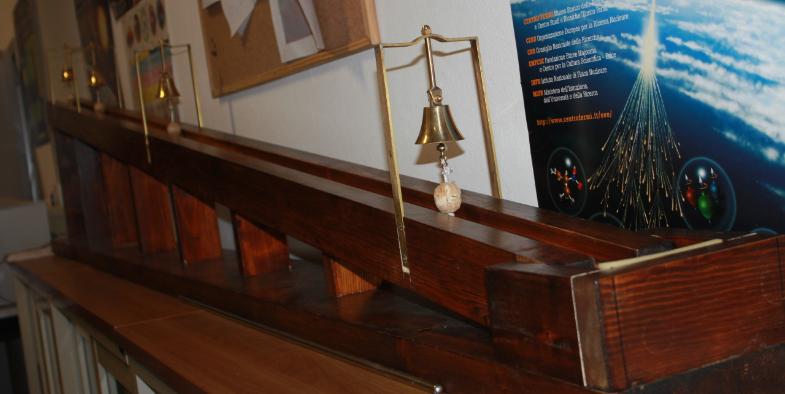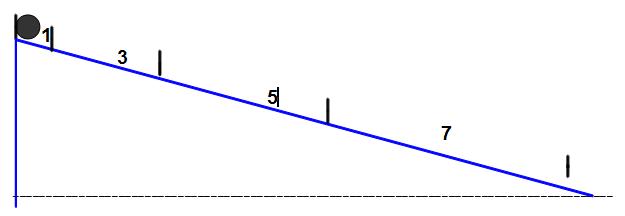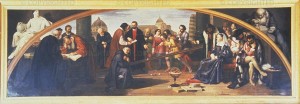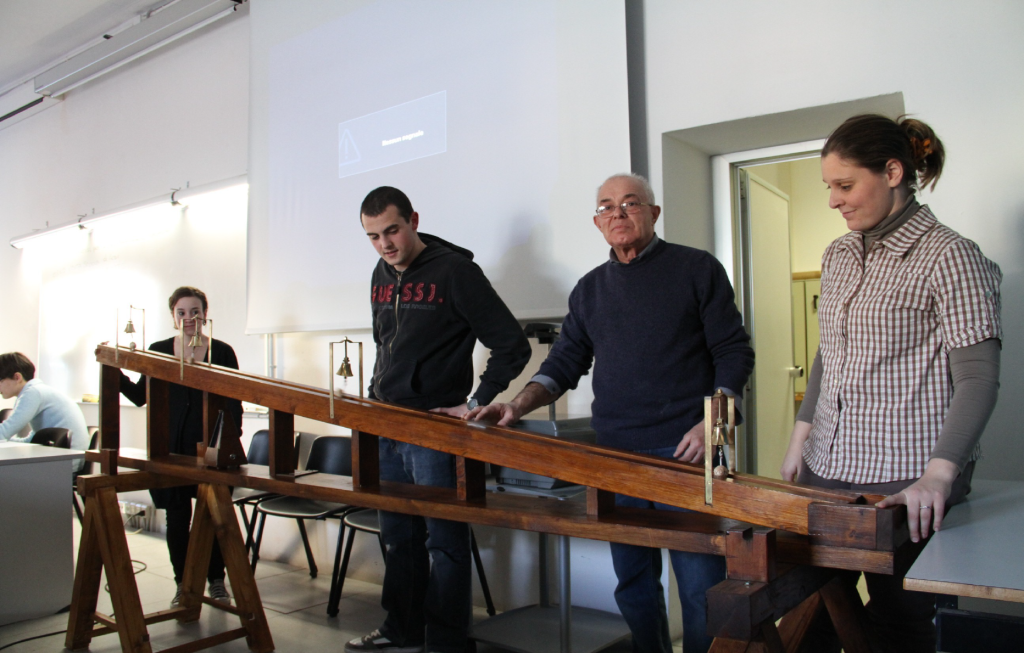Galileo’s inclined plane

We questioned ourselves how did Galileo Galilei demonstrate that the fall of a body causes an increase of its velocity. Being the free fall motion to fast for him to observe it in detail, in order to perform measures and deeper studies, Galilei conceived a “fall plane” not perpendicular to the ground (as it happens in free fall, with an agle of 90°) but with a reduced slope and therefore with a slower and easier to be measured fall, his famous so called “Inclined Plane”.
Performing measures and studies on it, Galilei noticed a relation between the distance travelled while accelerating and the odd numbers. In facts, he found fixing a constant sampling frequency (he used the heartbeat as reference and a water hourglass as precision instrument), the sphere the plane travelled longer distances while rolling down the plane. Fixing as distance unit what travelled in the first time interval when starting from stationary, he found that the second distance travelled in the same time interval was exactly 3 times the reference distance, the next one was 5 times it and so on.
Galileo said that the travelled distances starting from stationary are “in the same proportion as the subsequent odd numbers ab unitate”, i.e. the odd numbers series. 
This means that starting from rest if in the first time interval the distance is 1, doubling the time the distance becomes 1+3 = 4 times, tripling the time the distance becomes 1+3+5 = 9 times, multiplying the time by 4 the distance becomes 1+3+5+7 = 16 times and no on.

In this way Galileo found that during the descent, independently from the inclined plane angle, the distances increase with the square of the time intervals: taking this result to the limit of a 90 degrees descent, i.e. a free fall, Galileo found that “the travelled distances are among them as the square of the times”.
When put to the test…
Galileo himself described the experiment in his “Discourse, Mathematics, Demonstration, and Science in Galileo’s Discourses Concerning Two New Sciences”, published for its first time in Leiden, The Netherlands in 1638. Talking as Salviati, Galileo described the experiment, repeated many times in front of students and friends, which confirmed that the movement of a ball descending and inclined plane is accelerated constantly. “In a wooden measuring rod, about 12 arms long and half an harm wide in one way and 3 fingers in the other, a small canal had been hollowed out on the smaller width, a bit larger than one finger: after tracing it very straight, and, in order to have it well clean and smooth, gluing inside it a sheepskin shone as much as possible, a very though bronze ball, well rounded and cleaned, was made climb down in it; once the mentioned leaning measuring rod was created, arbitrarily lifting one of its ends of one or two arms above the horizontal plane, the ball (as I said) was let descend in the mentioned conduit, noticing, in a way that I will now say, the time that it consumed to travel along all of it, repeating the same act many times in order to carefully ensure the time quantity, in which not even a difference as big as a tenth of a heartbeat was ever found. Once this operation was done and precisely established, we let the same ball climb down only for the fourth part of the length of the canal itself and, once the descent time was measured, always the very precisely half of the other one was found; and repeating then the experience of other parts, examining now the time of the whole length versus the time of the half, or versus the one of the two thirds or ¾, or with any other fraction, via experiences repeated a hundred times it was always found that the travelled distances are among them as the squares of the times, and this at any plane inclination, i.e. of the canal in which the ball was let fall; we further observed that the time of the descents for different slopes exquisitely maintain among them the same proportion that we will see now being appointed and demonstrated by the author. Talking about the measurement of time, it was kept, hung from above, a big bucket full of water which, through a small cane welded to its bottom, poured a fine water blade, which was being received with a small glass for the whole time and once collected, the water was each time with a very exact scale weighed, giving us the differences for while the ball was going down the canal and its parts; the particles of water gave us then, in the same proportion of the weighs the differences and proportions of times; and this with such a correctness that, as I said, those operation, more and more times repeated, never differed of a noticeable moment.” We decided within our group to identify ourselves with Galileo Galilei (Pisa 15564 – Arceti 1642) and to reconstruct this historical experiment of the inclined plane, so to be able to live again life as it was at Galilean times, when our “advanced” instrumentation was not available. This is the exact reason why the group is named as “classic physics” group. Our path “in the Galilei’s footsteps” began with the construction of a small scale mockup of the original plane, which anyway resulted to be quite rough but helped us to experience, at first hand, the difficulties in which we would have stumbled while building the real plane. Moreover, this was a starting point both to deepen our trigonometry theory and to better understand the thought of the scientist. Once the mockup was completed, we proceeded with the construction of the in inclined plane in its original scale: this resulted to be much harder than expected for different reasons, related to deciding the slope angle (in the order of 8-9°) that allowed 4 bells i.e. 4 distances that would be travelled each in hald a second, to placing the bells at the right position, to build their support and, last but not least, to the friction that the iron ball had rolling in the plane canal. This was considerably reduced polishing the canal with very fine sandpaper and covering it with a special wax for wood. The measurement of time was performed a metronome set with a half-second frequency, in order to have its beat synchronized with the bells ring. Once the plane was completed, we built some supports in order to allow it to be transported and be shown also outside the Association laboratory. The inclined plane is visible to public for anyone who wishes to visit us in our laboratory in the Delfino building at the side of hall 101 of the University Campus of Savona.


Leave a reply
You must be logged in to post a comment.